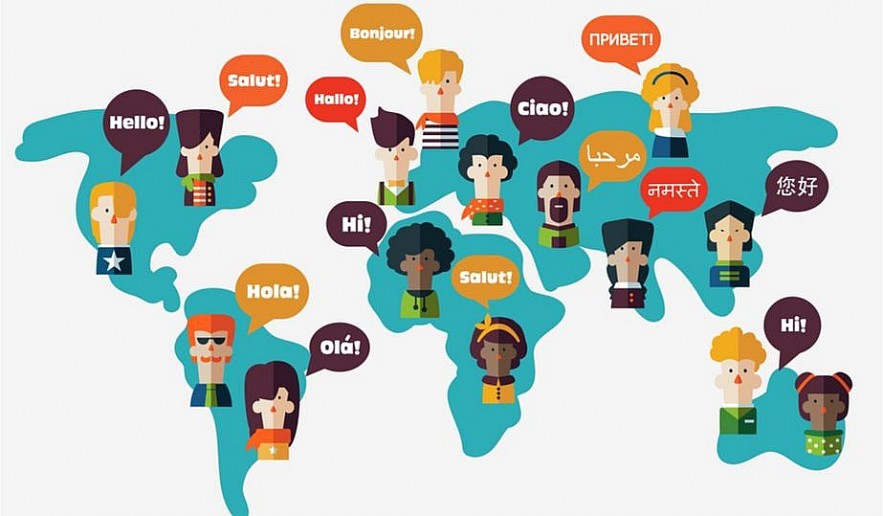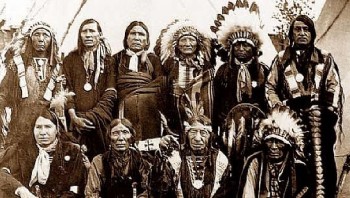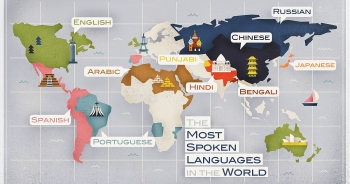Top 20 of the World's Rarest Languages Still Spoken Today
 |
| Rare Languages Still Spoken Today |
| Contents |
7,000 Living Languages Will Die
The most unique invention made by humans is culture. It defines its members and sets the rules for their everyday existence. The most basic element of culture is language. We don't know the earliest language spoken by humans, but we do know some very old ones.
When people talk about languages, they most often mention English, German, French, and Spanish. Japanese, Arabic, Russian, and Latin are also occasionally mentioned. Many speakers of today take their language skills for granted. Without this, there wouldn't be any way to communicate with other people. Imagine what it would be like if there was no language barrier between you and those around you. It is theoretically possible for people to write books and novels, but it is highly unlikely that other people could comprehend them. Our lives are impacted by language in ways we may not even be aware of.
The world's least common language can also be determined. But even in cases where they were once widely spoken, languages also disappear. Since the once-dominant Latin language is now extinct, it provides a great example of this phenomenon.
Within the next century, experts believe that half of the 7,000 languages still in use will become extinct.
Protect and Save Language
For a variety of reasons, a sizable number of languages have been lost to history. The causes are traditional colonization, declining population groups, and a lack of funding or investment in cultural heritage. Ad Astra does not take the news of extinct languages well because we are lovers of culture, language, and history.
We are witnessing increased attention and pushes for technology and digital archiving as a new method for preservation thanks to the digital world and contemporary technology. Additionally, Ad Astra makes sure that those who still speak extinct languages can access the communications and services they require.
Top 20 Rarest Languages Still Spoken Today
1.Taushiro (Pinche/Pinchi)
Native to Peru, the language of Taushiro is spoken along the Tigre River and Aucayacu River, which are tributaries of the Ahuaruna River. It is referred to as a language isolate because there is no discernible connection to any other language. Those who knew the language typically only used their fingers to count up to ten.
To say "one" in Taushiro, for instance, you would say washikanto. You would say "ashintu" and point to a toe on your foot to say a number greater than 10. One person only speaks the Taushiro language fluently, according to a 2008 study on the subject. Since then, the language has been classified as almost extinct.
2. Kaixana (Caixana)
One of the many seriously endangered languages that still exist today is kaixana. The language was once used in a Brazilian village by the banks of the Japura River. Portuguese settlers gradually occupied the region.
Nearly 200 people once knew how to speak it. However, a 2006 study found that there was only one other speaker of Kaixana, making it a language that was destined to go extinct.
3. Lemerig (Pak, Bek, Sasar, Leon, Lem)
Lemerig comes in at number three on the list and is the language of Vanuatu, an island nation in the southern Pacific Ocean about 1,000 miles east of northern Australia. More specifically, Vanua Lava Island is where this language is spoken.
A 2008 study found that there are only two fluent speakers of the language today, making it one of the list's nearly extinct languages. There are at least four distinct dialects of Lemerig, all of which are likely extinct.
4. Chemehuevi
Chemehuevi is primarily spoken in states in the Midwest and along the west coast. It is an Uto-Aztecan, Northern Uto-Aztecan, Numic, Southern language. In Ute, Colorado, Southern Paiute, Utah, Northern Arizona, Southern Nevada, and Colorado River, California, you might hear the language being spoken.
The Chemehuevi tribe is still around and doing well, but there aren't many people who can speak it well. According to a 2007 study, there are only 3 adults who are native speakers of the language. In Chemehuevi, words like kaiv (mountain), hucip (ocean), mahav (tree), and tittvip (ground/soil) can be used to discuss natural phenomena.
5. Njerep (Nigeria)
Nigerians speak the Bantoid language of Njerep. There is no longer any use of the language in Cameroon. Nowadays, people speak it mostly in the Mambila region. The language is no longer spoken; instead, Mambila dialects like Ba and Mvop have taken its place.
According to a 2007 study, there are only 4 people who still speak Njerep, making it a critically endangered language. The language will probably be extinct in a few centuries because those who do speak it are elderly.
6. Tanema (Tanima, Tetawo in Solomon Islands)
Tanema was once spoken in the Solomon Islands in communities like Vanikolo Island, Temotu Province, and an Emua village. According to a 2008 study, there are only 4 people who still speak the language today. Due to this, the language is seriously endangered.
In addition to being Malayo-Polynesian, Central-Eastern, and Oceanic, Tanema is Austronesian. Many people who once spoke Tanema have switched to Pijin or Teanu, two languages that are very common in the area, as a result of adaptation. Want to learn Tanema's verbs? To turn, swim, work, and lie down, try wekini, laro, la vamora, and la munana.
7. Liki (Moar), Indonesia
Speaking in the islands off the north coast of Sarmi, Jayapura Kabupaten, and Sarmi Kecamatan, all of which are islands close to Indonesia, is the critically endangered language of Liki. A 2007 study found that there are only 5 native speakers. All local church leaders who lived in the area spoke the language in the past.
In addition to Austronesian, Malayo-Polynesian, Central-Eastern, Eastern Malayo-Polynesian, Oceanic, Western Oceanic, North New Guinea, Sarmi-Jayapura Bay, and Sarmi, the language is thought to have multiple origins.
8. Ongota/Birale in Ethiopia
The Ongota language was reportedly still on the decline in 2008. The language is only known and used by six elderly native speakers. Due to this, the language is seriously endangered.
Ongota, however, is actually being studied by a professor at Addis Ababa University in Ethiopia, unlike the majority of languages that are going extinct.
He has come to the conclusion that the language has a subject, object, and verb structure. Ongota is allegedly an Afro-Asiatic language spoken in a small village in Ethiopia on the west bank of the Weito River.
9. Dumi in Nepal (Dumi Bo’o, Dumi Bro, Lsi Rai, Ro’do Bo’, Sotmali)
In areas close to the Tap and Rava rivers, people typically speak the Nepalese language of Dumi. In the eastern Nepali district of Khotang, which is home to mountains, it is also spoken. It belongs to the Tibeto-Burman language family because it is a Kiranti language.
The language was only used by 8 people in 2007, making it critically endangered. A dictionary of the Dumi language is available, and information about it has been gathered over time. Numerous books have also been written about the syntax and grammar of the language.
10. Chamicuro in Peru (Chamekolo, Chamicolo, Chamicura)
According to a 2008 study, there are 8 speakers of Chamicuro in the entire world. The majority of those who still speak the language, which is primarily spoken in Peru, are older, and it is currently thought to be critically endangered. Because the area has adapted to speaking Spanish, there are no children who speak Chamicuro.
But those who could speak it were able to create a dictionary of its words. Use these if you ever need to learn a few animal names in Chamicuro: the waka (cow), the ma'nali (dog), the mishi (cat), the polyo (chicken), the duck, the katujkana (monkey), and the kawali (horse).
With no native speakers alive, this tongue from Peru is considered dormant. However, a dictionary of Chamicuro exists, which can help those who want to learn it.
11.Turkish Bird Language
Known as Kuş Dili in Turkish, this bird language is one of the most uncommon languages in the world. It has no alphabet and is made up entirely of whistles and melodies. Since mobile phones help people communicate over long distances now, this tongue is in danger of becoming extinct.
12.Kalasha-mun in Pakistan
The Kalash people of Pakistan's Chitral District speak the Indo-Aryan language Kalasha (also spelled Kal'as'amondr).
Experts worry for its survival because only 5,000 people can speak it.
According to Kalash expert Badshah Munir Bukhari, "Kalasha" is also the ethnic name for the Nuristani people who live in the Waygal and middle Pech Valleys, which are located southwest of the Kalasha Valleys in Afghanistan's Nuristan Province.
The Nuristanis of Waygal, who at one point expanded their territory northward into southern Chitral, are credited with introducing the name "Kalasha" to the Kalash people of Chitral.
13. Pirahã in Brazil
There are roughly 250-380 speakers of this indigenous Brazilian language. It is the last surviving variety of the Mura language.
The Pirah live in the municipality of Humaitá in the Brazilian state of Amazonas, on a stretch of land that the Marmelos river and nearly the entire length of the Maici river pass through.
Even if they don't speak it fluently, most men can understand Portuguese. The Portuguese language is rarely used as a means of communication among women. With the help of the locals, the men created a contact 'language' by combining words from Pirah, Portuguese, and the Amazonian lngua geral (a Tupi-based trade language more commonly known as nheengatu).
14. Pawnee (Native Americans)
This language was used by the Pawnee Native Americans, but it gradually lost significance. Due to children focusing more on English, there are currently only ten people who speak this language.
Native Americans who are still semi-nomadic in nature, the Pawnee originally inhabited the Great Plains, primarily in what is now the state of Nebraska. Early European exploration brought them into some contact with white people, but until the late 18th century, that contact was quite limited. From the 19th century onward, this contact with white settlers completely altered the Pawnees' way of life.
 Who Are The Native Americans: Culture, Traditions and Religions Who Are The Native Americans: Culture, Traditions and Religions |
15.Paakantyi (Darling language) in Australia
This Australian language only had four speakers in 2005, but the number had increased to 42 in 2016.
The Paakantyi language, also known as the Darling language and written Paakantji, Barkindji, Barkandji, and Baagandji, is almost extinct. Language used by Australian Aborigines along the Darling River in New South Wales from Bourke to Wentworth and in a large portion of the area in the backcountry near the Paroo River and Broken Hill.
Using the "belonging to" suffix, the people's and language's names refer to the Paaka (Darling River). The Paakantyi (or a similar spelling) are the people who speak the language.
16. Tunebo in Colombia
The Uwa people of Colombia speak tunebo. There are about 3600 native speakers. One of the few uncommon languages with a writing system and dictionary is this one.
In northeastern Colombia's plains and forests of the Andes, there are roughly 2,700 Tunebo people. Their various regional groups call themselves U'wa, or "people," and they speak various dialects of the Chibchan language.
Three regional groups of Tunebo exist in addition to a small group of about 60 people on the Angostura reservation. There are about 400 members of the Eastern Tunebo (Barro Negro), who live on the edge of the eastern plains in the Andes foothills above Paz de Ariporo, in Barro Negro, San Lope, and Tabas, south of Tame. With settlements in Satocá, Calafita, Tegrá, and Cobará, the Central Tunebo (Cobara), a group of about 1,500 people, live on the northern slopes of the Sierra Nevada de Cocuy in the Boyacá and Arauca regions. In San Camilo, Venezuela, there is also a small group of Central Tunebo. About 700 members of the Western Tunebo (Agua Blanca) population reside in Santander.
17. Mudbura in Australia
Mudburra, also known as Pinkangama and written as Mudbura, Mudbarra, and other variations, is an Aboriginal language spoken in Australia.
Karrangpurru may have been a Mudburra dialect, as some people have claimed. But because it is undocumented, it cannot legally be classified.
While other reports claim that fewer than 10 people are fluent in the Mudburra language, data from the 2016 Australian census showed that 96 people did. Additionally, it was stated that youngsters no longer study the language in its traditional form.
18. Hértevin in Turkey
There are 1,000 people who speak this rare language. Although it has speakers all over the world, its speakers are originally from Turkey. Today, the majority of Hértevin speakers are exiles.
Despite having records dating back to the sixth century BC, Hertevin was not formally acknowledged until the twentieth century.It is a member of the Neo-Aramaic family of languages.
The dialect was given its name in honor of a village in extreme southeast Turkey. 500 people lived in the Hertevin village in the 1970s, and many of them spoke the language. By 1990, however, only one Hertevin-speaking family remained. Hertevin speakers were forced to leave because of targeted violence during the Armenian Genocide, in contrast to most endangered languages that are under threat from globalization.
Hervetin speakers are becoming fewer and farther between as a result of the dispersal of residents from this area. But after the Gulf Wars, many Chaldean Catholics relocated to Paris, where they were joined by Iraqi Christians. The mass is read in Chaldean languages in addition to French in a cathedral in Paris' 18th arrondissement.
19. Ishkashimi in Afghanistan and Tajikista
There are fewer than 3000 speakers of this language in Afghanistan and Tajikistan. Ishkashimi has no writing system, making study extremely challenging.
Because everything in our world is transient, it is crucial to our cultures and languages. A language's speakers numbering in the millions does not guarantee that it won't go extinct in the future. We should pay close attention to everything around us because it could vanish at any time.
20. Jedek in Malay Peninsula (Malaysia)
A previously undiscovered language called Jedek was discovered by a Swedish linguistic team from Sweden's Lund University while researching the Jahai language, which is spoken by a small community in the Malay Peninsula.
There are 280 people who identify as ethnic Batek or Menriq and speak Jedek. The dialect used in Peninsular Malaysia is quite different from the other Aslian-family languages spoken elsewhere in the world. Malaysia acknowledges a number of Aslian
The inhabitants of Sungai Rual speak Jedek. The village is found in the Malay Peninsula's state of Kelantan, close to the town of Jeli. They reside close to the region where Jahai speakers reside. The hunter-gatherers who now live in the village are the Jedek speakers.
| Sentinelese This tongue is spoken by the Sentinelese people. Its speakers can be anywhere between 100 to 250. Not much is known about the tongue since outsiders are not allowed on the island of Sentinelese people. Rotokas Spoken on the island of Bougainville, Rotokas has only 13 alphabets. It had 4,300 speakers in 1981. Ormuri Spoken by the 2300 years old tribe of the Burki people. It had 6000 speakers in 2004. The importance of Pashto in the region has endangered Ormuri. |
In Conclusion
There are still many rare languages spoken today because the world does not easily give up on things. There are very few speakers of these endangered or extinct languages. These twenty still-used tongues are examples of such dialects.
Despite the fact that speaking a language seems to be essential, the UN reported that a language disappears on average every two weeks. Due to factors like language speakers dying off, some languages integrating, and some languages being more common than others, these languages are rapidly disappearing. A culture can be said to have died when a language did, in some ways.
 What Is the Official Language Of The U.S - Top 10 Most Common Languages What Is the Official Language Of The U.S - Top 10 Most Common Languages Most of people in the US speak English but do you know English is not the official language of this country. So what is the ... |
 Top 10 Hardest Languages To Learn in The World Top 10 Hardest Languages To Learn in The World There are thousands of languages spoken in the world. It's hard to make a list of languages that are hard to learn for everyone. So ... |
 Top 7 Most Spoken Languages In the World Today Top 7 Most Spoken Languages In the World Today Which languages do the majority of the world's population speak? This article should help you with what seems to be a difficult question. A pleasant ... |























